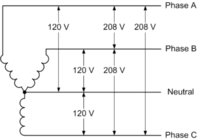Some more methodical fiddling around led me to finding that if the rectifier was plugged in there would be continuity between stator yellow and frame. Rectifier unplugged would remove this path.
Red lead on Yellow, Black on frame
- w/rect 20.5MOhm
- w/o rect ---
Black lead on Yellow, Red on frame
- w/rect .5MOhm
- w/o rect ---
Testing the rectifier itself, the 1st of my 'better' rectifiers, it still looks good.
Using the VOM's diode setting, everything checks out great. Voltage drops of about 400 all across in one direction, infinity in the other.
With the rectifier and battery back in line, I measured the Yellow wire voltage against frame ground.
At idle, the same 1.3-1.7vac wandering I got before.
Revved, it'll go as high as 7.x, but it's all over the place. Usually between 4 and 7v.
When it's behaving and keeping to 5-7v my mounted voltmeter shows 13.8/9vdc which is good, there's a ~.3v drop between it and battery.
Every once in a while while revving the yellow wire's voltage drops real low to 1 or 2v. At those times the mounted voltmeter drops to the low 13s.
The yellow wire should measure around 14 volts AC with the engine idling.
Confirming this. Curly's List looks for 10.5-11vac between each of the white wires. Shouldn't ~7vac or a little over half of the phase-to-phase voltage be what we're looking for?
-Still Chasing Ghosts in Phoenix



